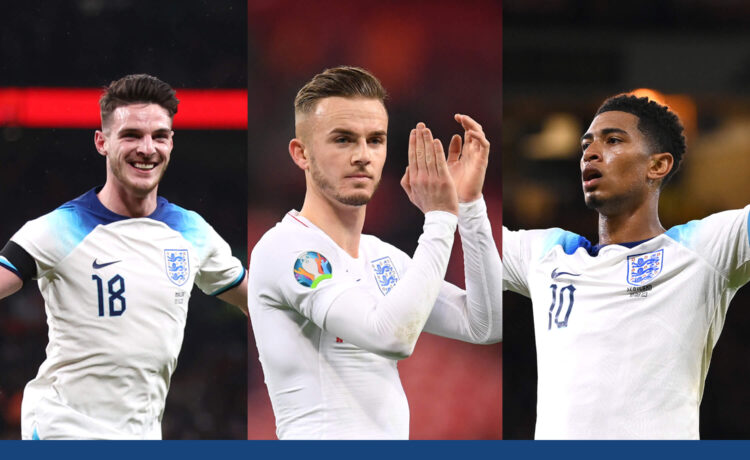This is the latest in a four-part series examining the selection decisions Gareth Southgate has to make before this summer’s European Championship.
Part one was on the goalkeepers.
Part two looked at the defenders.
Realistically, two-thirds of England’s starting Euro 2024 midfield picks itself if everyone is fit and available.
In October, I wrote that manager Southgate has to make the 4-2-3-1 his tactical blueprint this summer. This centralises the midfield on Jude Bellingham. He can be an everything midfielder, and is at his best playing as a No 10.
Bellingham had coming-of-age performance after coming-of-age performance at the 2022 World Cup. He had the most shot-creating actions (17) of any England player and was successful with 15 out of 16 tackles — three times more than any of his compatriots. It started in game one, when Bellingham headed in the opener against Iran and England won 6-2, and did not stop all tournament.
“For someone of his age to show such maturity and intelligence is unbelievable,” Southgate said of the 20-year-old in October.
“We are lucky to have him. He’s been the catalyst,” he added, referencing England confirming their place in the Germany-hosted tournament by beating Italy 3-1 at Wembley, 15 months on from losing the Euros final to them on penalties in the same stadium.
In that win, Bellingham completed 31 of his 35 passes, made a game-leading three interceptions, was successful with three of four dribbles completed and won four fouls, most of any player on the pitch. See? An everything midfielder.
England’s first two goals were also made by Bellingham.
He won the penalty from which Harry Kane equalised, receiving Declan Rice’s midfield-splitting pass and flicking it around the corner to the No 9:

He then ran immediately between Italy’s centre-backs, taking the ball out of Kane’s feet, like an American football running back receiving a handoff from the quarterback…

… and dribbling into the box, where he was fouled by Giovanni Di Lorenzo before he could shoot.
The second featured a blistering dribble on the counter-attack from his own half, followed by another off-the-ball run. This time, he went inside covering full-back Destiny Udogie, after passing wide to Marcus Rashford. That movement took Udogie out of the way, creating space for Rashford to cut inside and find the far corner.
Bellingham’s box-crashing has been at record-breaking levels in his debut season at Real Madrid: 20 goals in all competitions, 16 in La Liga (it says 15 in the graphic below because one was a penalty) — 14 of which have been scored from inside the opponents’ penalty box.

He perfectly compliments Kane’s style of dropping deep, and England ought to maximise midfield goal threat, given their dependence (albeit not reliance) on their No 9. Only three other players have more than 10 England goals under Southgate — Raheem Sterling has 18, Rashford 16 and Bukayo Saka 11; and Kane’s 57 means he has more than that trio combined.
Bellingham’s role also works because of Rice.
While he has shown versatility in acting as a box-crashing No 8 for Arsenal recently, Rice is, at his core, a ball-winning No 6. He can play on his own in the build-up, linking defenders to forwards, and is one of the best in the world at aggressive jumps onto opposition midfielders in a high press.
All of the above gives Bellingham licence to roam, not to mention that Rice can also rotate into full-back spaces or play between the centre-backs. This allows England to get greater support (over/underlaps) to the wingers, particularly Saka, who can expect to be doubled-marked.

That third central midfielder, then.
A second Rice-type would be a little too defensive, for two reasons. One, England’s favourable group (Serbia, Denmark, Slovenia) means they can expect to dominate the ball in the tournament’s early stages. Two, “we don’t have many players of that profile”, is what Southgate said after leaving Kalvin Phillips, the most similar midfielder to Rice available, out of the squad for this week’s internationals against Brazil and Belgium due to poor club form.
If Southgate sticks with Jordan Henderson, it will disappoint many. Beyond questions of his current playing level, having left Liverpool last summer for the Saudi Pro League, before returning to Europe in January with an Ajax side now 31 points off the top of the Dutch Eredivisie, his age ought to factor in. He will turn 34 three days into these Euros, almost certainly making this his final tournament, if selected, and with the depth and versatility of England’s midfielders, there is little short- or long-term benefit to keeping Henderson there.
Southgate sees Trent Alexander-Arnold’s role as a pure midfielder now, so different to Jurgen Klopp using him in a hybrid full-back/midfield role for Liverpool. International games are notoriously slower than those at club level, and England expect to face compact mid/low-blocks more than the high press. Against such teams, more likely in the group than (possible) knockout stages, Alexander-Arnold’s passing range, particularly through balls and switches, would be valuable.

Defending and positional awareness have never been Alexander-Arnold strengths, and he might get overrun against sides with better midfields. Conor Gallagher would suit such games against stronger teams. He was described by Southgate, positively, as a “slow-burner”, having not quite been a standout in England’s age-group sides. Gallagher’s off-ball tenacity and pressing are standouts, but he has refined his technique — he is the only Chelsea player this season in three figures for both progressive passes and combined tackles plus interceptions.

“When you look at midfielders, you often ask: do they stop goals, create goals or score goals? He does a lot of all of that,” Southgate said of Gallagher upon naming him in the 2022 World Cup squad.
The downside? Gallagher is still in the infancy of his international career, with 11 caps. He was an unused substitute in all five games at the World Cup and is yet to play a full 90 minutes for England. He, Rice and Bellingham would be a midfield for the future, not just for now. Rice, who turned 25 in January, is the oldest of the trio.
Southgate has taken five midfielders to two of his three major tournaments as England manager, naming a sixth for Qatar 2022 when the squads were three players larger. Three first-choice midfielders, plus Alexander-Arnold being in the defenders category but capable of moving infield, leaves space for two others. Logically, this leaves one wildcard pick and one under-21 taken along for the experience.
Technically these categories can overlap, but let’s separate them.
First, the wildcards: Ruben Loftus-Cheek, James Maddison and James Ward-Prowse are three of England’s more specific midfielders but all offer final-third output. Southgate is hyper-aware of taking positionally and tactically adaptable players considering smaller squad requirements at Euro 2024 (back to the traditional 23 players again, not 26 as at Euro 2020 and the following World Cup). He speaks of “specialists” — England can afford one of those in midfield.
Southgate recalled Maddison last March (for the first time since he debuted as a Leicester City player in November 2019), citing a change in England’s system that had made space for a No 10. An injury-ridden first season with Tottenham Hotspur has limited Maddison’s minutes — Southgate has spoken of caution around taking “physically vulnerable” players with a smaller squad — following an excellent start to it on the pitch.
At his best, Maddison is phenomenally creative in open play and at set pieces. He can drop deep and break lines, or play further upfield, receive in tight spaces, and shoot from distance. Bellingham’s presence has forced Maddison to play off the left in recent internationals; with him playing as more of a passer than a dribbler, he and England both look less threatening.

Ward-Prowse is the best English set-piece taker. He has a unique direct free-kick technique, consistently scoring with whip and dip over the wall, and his dead-ball delivery has been maximised at new club West Ham United this season — 12 assists in all competitions. For an England team with such set-piece strength, he fits in theory, but he offers a lot less than others in open play.

GO DEEPER
James Ward-Prowse’s brilliant free-kick technique: The biomechanics analysed
Just 11 caps for Ward-Prowse since a debut in March 2017 illustrates his bit-part role — very much a backup to be turned to when others are injured — and he has not been part of a squad since September 2022. The “take Ward-Prowse for set pieces” argument becomes a strawman when you look at other available players.
Alexander-Arnold ranks fourth and Kieran Trippier fifth among Englishmen for dead-ball shot-creating actions in the Premier League this season. Rice’s inswinging corners from the left have been essential to Arsenal’s phenomenal set-piece output this season. All those are right-footers, like Ward-Prowse. Phil Foden and Luke Shaw, providing the former is on the pitch and the latter fit, cover left-footed delivery.
Loftus-Cheek would be the biggest wildcard of the lot: part of England’s 2018 World Cup squad — Southgate’s first major tournament — but not capped or even called up since the autumn of that year.
However, he has revitalised his career at AC Milan, after leaving Chelsea for Italy last summer, importantly playing a box-crashing No 8 role in a 4-3-3 that is not dissimilar to England’s. This is already his most minutes across all competitions in a single season (2,416), which underlines his horrible injury record in recent years, while only in 2018-19 (10) did he score more goals than his current total of nine.
His exclusion from the squad for these two upcoming friendlies suggests he still has work to do to convince Southgate of his worth.
There are four contenders for an under-21s pick: Manchester City’s Rico Lewis, Curtis Jones of Liverpool, Everton’s James Garner and Kobbie Mainoo, who plays for Manchester United.
Southgate gave Lewis his first senior cap in November, starting against North Macedonia the day before he turned 19, although he has only played four times for the under-21s. Similarly to Alexander-Arnold, he can play a hybrid role between full-back and midfielder, and is right-footed. One for the future, certainly, but suffering because England have others with his profile.
Jones and Garner were in the England Under-21 team that won their age-group Euros final last summer. Both showed positional flexibility, fulfilling wing-back roles, while Jones has played as a false nine too. With 20 and 18 under-21 caps respectively, both have sufficient experience at that level, and are tidy technically — either could play deeper to facilitate Rice going forward. While Jones has had injury issues this season, Garner has played almost 92 per cent of league minutes, albeit in an Everton system that is tactically polarised to England.
Mainoo has been one of the youngsters of the season in the Premier League, a revelation in a struggling United midfield. His balanced style is valuable: press-resistant to receive in build-up, capable of defending his box and comfortable breaking lines via both passes and carries.

(Robbie Jay Barratt – AMA/Getty Images)
“We’re never slow to put a young player into the seniors,” Southgate said this month of Mainoo, who turns 19 in April. “But he’s only had a handful of games and you must be very careful, development-wise, in making those decisions at the right time. So we think, ideally, we should allow him that space to develop at his own speed. He is not at the point in terms of number of games that Jude Bellingham or Bukayo Saka were at when they came in for the first time.”
But football moves fast when talent makes itself this obvious, and this week Mainoo, was drafted into the senior squad a few days after a standout display against Liverpool in the FA Cup. He did not replace an injured player — he was simply promoted on ability, and with Bellingham (only 22 months older than him) as an example, Mainoo now has an opportunity to stake his claim for a place in Southgate’s squad for the finals, at the very least.

GO DEEPER
Kobbie Mainoo, an 18-year-old playing like a seasoned pro
The phrase “golden generation” has become hackneyed in international football, especially when used about England’s midfield in the early 2000s, but the nation currently has central midfield options with quality and experience beyond their years.
That means solving the third central midfielder conundrum — and picking the right profile for the position, based on the game state and opposition tactics — is Southgate’s biggest problem.
And as problems in international football go, it’s not a bad one to have.
(Top photos: Getty Images)

















